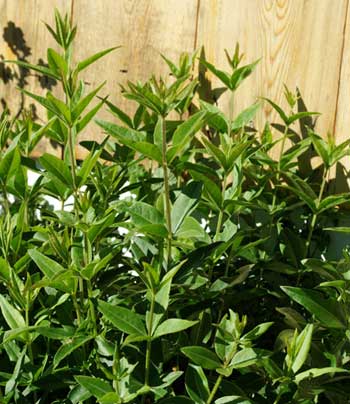Contents:
Common Names | Parts Usually Used | Plant(s) & Culture | Where Found | Medicinal Properties | Biochemical Information
Legends, Myths and Stories | Uses | Formulas or Dosages | How Sold | Bibliography
Scientific Names

- Rubia tinctorum L.
- Rubiaceae
- Madder family
Common Names
- Dyer’s madder
- European madder
Parts Usually Used
Rootstock
Back to Top
Description of Plant(s) and Culture
Madder is a European herbaceous perennial plant; a cylindrical, reddish-brown, creeping rootstock up to 3 feet long produces several angular prostrate or climbing stem s, as long as 8 feet, which bear lanceolate leaves in whorls of 4-6. The flowers are small and yellow-green, in clusters on spikes which top the stalks.
Another variety: Used in Ayurvedic medicine, the Indian madder(R. cordifolia), in Sanskrit the name is Manjishta, Chinese name Ch’ien-ts’ao or Qian cao, has similar properties and uses as European madder (Rubia tinctorum).
Back to Top
Where Found
Grows in the Mediterranean area, native to southern Europe and western Asia.
Back to Top
Medicinal Properties
Alternative, astringent, deobstruent, diuretic, emmenagogue
Back to Top
Biochemical Information
Purpurin, pseudopurpurin, manjistin, alizarin
Back to Top
Legends, Myths and Stories
Madder is a plant known almost exclusively as a dye plant. The long fleshy root, when dried and milled, yields a variety of colors: red, pink, brown, orange, black, lilac, and purple, depending upon the mordant used. Madder has been raised commercially for its dye value.
The trousers of the French soldiers of the 19th century and the head coverings of the Turks, the fezzes, once were dyed red with madder. This striking coloring agent held its own until aniline dyes came along.
It is the roots that contain the red coloring–today we know that it is due to anthraquinone derivatives.
Madder is one of the oldest coloring agents known to us; it was used in pre-Christian times by the Egyptians, Persians, and Indians.
Like many other Mediterranean plants, madder was brought across the Alps by Benedictine monks, and Charlemagne, in his capitulary on the management of his landed estates, called for it to be grown within his domain.
Back to Top
Uses
Madder is useful for all problems with the urinary tract, particularly where the urine becomes alkaline. It has been used for rickets, slow-healing broken bones, inflammations, lack of appetite, diarrhea, dropsy, jaundice, blood purifier, and fever. Externally, a decoction of madder can be used for skin problems, especially tubercular conditions of the skin and mucous tissue.
Back to Top
Formulas or Dosages
The rootstock is collected when it is 3 to 6 years old.
Infusion: 1 tsp. fresh or dried root to 1 cup water. Take 1 to 1 1/2 cups per day.
Decoction: boil 1 1/2 to 2 oz. rootstock in 4 to 6 qt. water for use as a bath additive.
Back to Top
How Sold
Capsules
Back to Top
Bibliography
![]() The Complete Medicinal Herbal
The Complete Medicinal Herbal, by Penelope Ody, Dorling Kindersley, Inc, 232 Madison Avenue, New York, NY 10016, First American Edition, copyright 1993
![]() Culpeper’s Complete Herbal & English Physician: Updated With 117 Modern Herbs
Culpeper’s Complete Herbal & English Physician: Updated With 117 Modern Herbs, by Nicholas Culpeper, Meyerbooks, publisher, PO Box 427, Glenwood, Illinois 60425, 1990, (reprint of 1814)
![]() Chinese Medicinal Herbs
Chinese Medicinal Herbs, compiled by Shih-Chen Li, Georgetown Press, San Francisco, California, 1973.
 The Healing Plants
The Healing Plants, by Mannfried Pahlow, Barron’s Educational Series, Inc. 250 Wireless Blvd., Hauppauge, NY 11788, 1992
![]() The Herb Book
The Herb Book, by John Lust, Bantam Books, 666 Fifth Avenue, New York, NY. copyright 1974.
Herbal Gardening, compiled by The Robison York State Herb Garden, Cornell Plantations, Matthaei Botanical Gardens of the University of Michigan, University of California Botanical Garden, Berkeley., Pantheon Books, Knopf Publishing Group, New York, 1994, first edition
![]() Indian Uses of Native Plants
Indian Uses of Native Plants, by Edith Van Allen Murphey, Meyerbooks, publisher, PO Box 427, Glenwood, Illinois 60425, copyright 1958, print 1990
![]() The Nature Doctor: A Manual of Traditional and Complementary Medicine
The Nature Doctor: A Manual of Traditional and Complementary Medicine, by Dr. H.C.A. Vogel; Keats Publishing, Inc., 27 Pine Street (Box 876) New Canaan, CT. 06840-0876. Copyright Verlag A. Vogel, Teufen (AR) Switzerland 1952, 1991
![]() Planetary Herbology
Planetary Herbology, by Michael Tierra, C.A., N.D., O.M.D., Lotus Press, PO Box 325, Twin Lakes. WI 53181., Copyright 1988, published 1992
![]() The Yoga of Herbs: An Ayurvedic Guide to Herbal Medicine
The Yoga of Herbs: An Ayurvedic Guide to Herbal Medicine, by Dr. David Frawley & Dr. Vasant Lad, Lotus Press, Twin Lakes, Wisconsin, Second edition, 1988.
![]() Webster’s New World Dictionary
Webster’s New World Dictionary, Third College Edition, Victoria Neufeldt, Editor in Chief, New World Dictionaries: A Division of Simon & Schuster, Inc., 15 Columbus Circle, New York, NY 10023
 The Rodale Herb Book: How to Use, Grow, and Buy Nature’s Miracle Plants (An Organic gardening and farming book)
The Rodale Herb Book: How to Use, Grow, and Buy Nature’s Miracle Plants (An Organic gardening and farming book), edited by William H. Hylton, Rodale Press, Inc. Emmaus, PA, 18049., 1974
